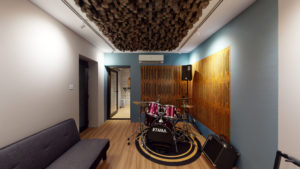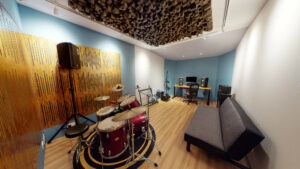Soundzipper Acoustic Consultant: Candice Yung
Main Contractor: G&H Renovation Pte Ltd
The Challenge
Soundzipper was tasked to provide acoustic design and build services for a home studio in a semi-detached house in Bedok, Singapore. The main objective of our design was to provide adequate acoustic treatment for 2 adjacent rooms. The main studio room would be converted into a mixing & recording studio, and the smaller room would become a movie room. The client’s expectations included having optimal acoustics at the mixing station and a better acoustically treated recording space. The main challenge for this project was to have an acoustic treatment design that can fit two purposes: (1) mixing and (2) recording, in the same room. Another challenge is that part of the ceiling of the space is slanted, so the allocation of space and acoustic treatment shall be carefully designed.
The Analysis
Pre-construction tests show that the Reverberation Time (RT) in the main studio was 1.4 seconds at 315Hz, the peak in RT indicated the current room and mixing station location were not optimal for mixing purposes. The room mode at the low frequency shall be eliminated, if not the overall sound would be unbalanced due to the distortion and loudness from the low frequency room mode and would affect rest of the frequency spectrum.
The acoustic treatment of the main studio was designed to control the RT at the mixing station, and correct the room modes to create a better response to improve audio quality.
The Design
Acoustic treatment is essential to tackle echos and provide the best listening and recording experience. Surrounding the mixing station, there are fabric panels and corner bass traps on the walls to control first reflections and bass frequencies. Above the mixing station, there is a full range membrane bass trap on the slanted ceiling to control the ceiling’s early reflections. Bass traps were incorporated to control the low frequency RT into relative uniformity with the mid-band RT. The surrounding bass traps have also helped to avoid the build up of low frequency standing waves, or resonant modes. As for the recording area at the back of the studio, there are several more diffuser finishes on the wall and on the ceiling. The reason for diffusers in the recording area is to achieve a livelier sounding recording area.
Post-construction test was conducted upon completion of the project. Our design reduced the averaged RT in the main studio, which complies with the specified design requirement. The design also corrected the room mode and achieved a much flatter response than before.
Bonus: Have a 3D VR experience of this space brought you by our brand new Matterport camera!


 ►
Explore 3D Space
►
Explore 3D Space


